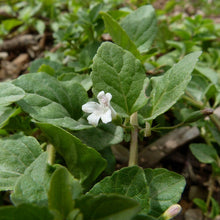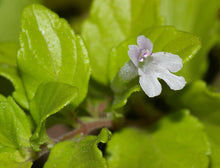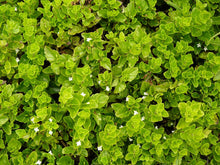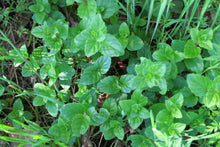
Clinopodium douglasii (formerly/aka Satureja douglasii)
This plant truly checks every box. The ultimate one-upper; yerba buena is a low-growing, native groundcover that’s evergreen, easy to care for AND bears cute, fragrant whitish-pink flowers that attract pollinators. A delicate member of the mint family, its aromatic vegetation spreads liberally but not obnoxiously and both the leaves and the flowers of this rambling herb are medicinal and delicious, particularly in tea.
- Plant type/canopy layer: evergreen, perennial, herbaceous plant
- Size at maturity: 0-6" tall, spreading laterally as a groundcover
- Light requirements: full shade, part sun/part shade
- Moisture requirements: moist soil
- Bloom time: May - August
- Growth rate/ease: medium to fast growing, very easy to grow
- Wildlife support: flowers attract and provide nectar to bees and other insect pollinators
- Native habitat/range: found in shady, moist woodlands at low to mid elevations from western Alaska south all the way to Los Angeles. In the Pacific Northwest, it is predominantly found from the coast to the west Cascades. Portland Plant List - yes
- Special features & uses: groundcover; landscape uses include pollinator gardens, landscape gardens, woodland gardens; both leaves and flowers are edible with a distinct spearmint flavor, while the leaves can be consumed medicinally or just joyfully as a tea; medicinally it has been used worldwide for millennia as a pain reliever for headaches, toothaches, and joint pains, as well as for gas and indigestion and to freshen breath, among many other uses.
Gardening with Yerba Buena: This species has a stoloniferous trailing habit, which means it does not spread by rhizomes like many other groundcovers, but instead by rooting itself as it travels. This growth habit makes it interesting and effective in shady borders, meandering through rocky areas and even in hanging baskets. It will thrive in areas that are mostly or entirely shade with moist, well-drained soil - but ultimately it’s not super fussy and can tolerate slower drainage. Since it is quite small, be careful it doesn't get covered up by mulch or larger plants.
Photo Credit - macro: "YERBA BUENA (satureja douglasii) (6-19-08) canet" by Sloalan is marked with CC0 1.0.
Photo Credit - flowerleavesclose: "Clinopodium douglasii (Yerba Buena) CA native" by PlantRight1 is licensed under CC BY 2.0.
Photo Credit - population: "Yerba Buena - Clinopodium douglasii" by docentjoyce is licensed under CC BY 2.0.
Photo Credit - leaves: "Clinopodium douglasii" by Ed Alverson is licensed under CC BY 4.0.







